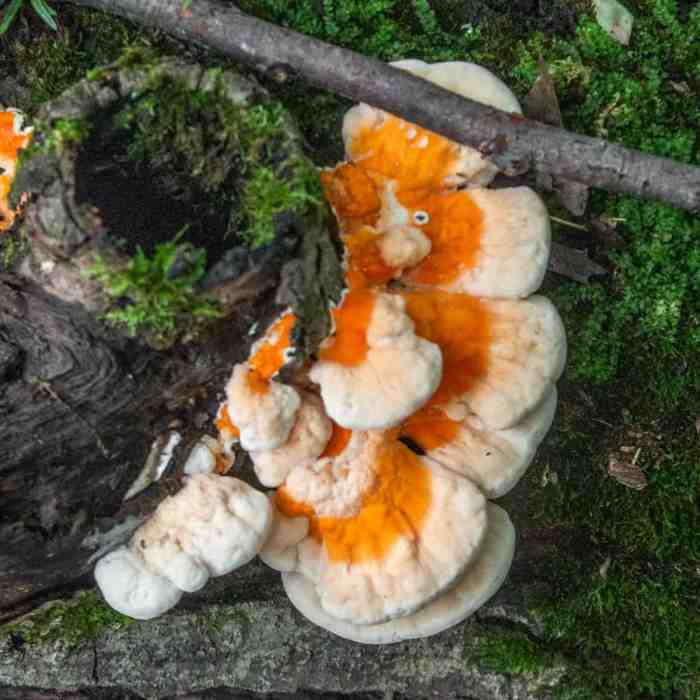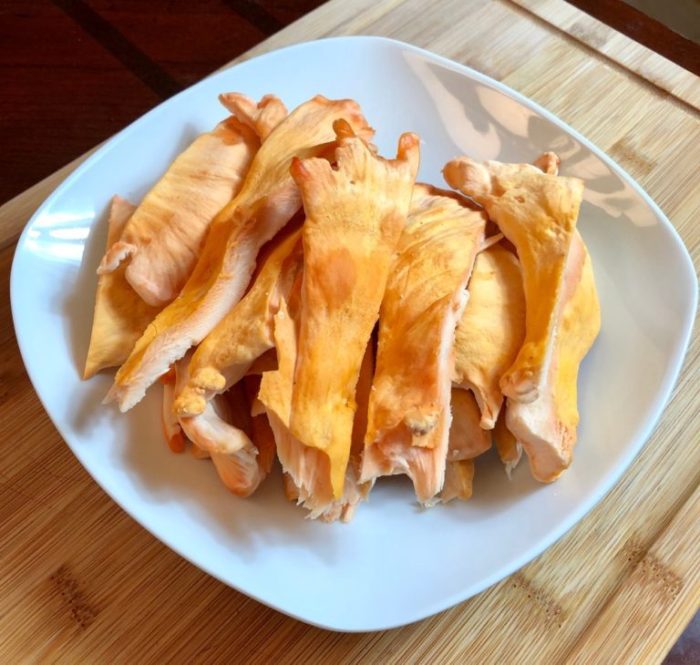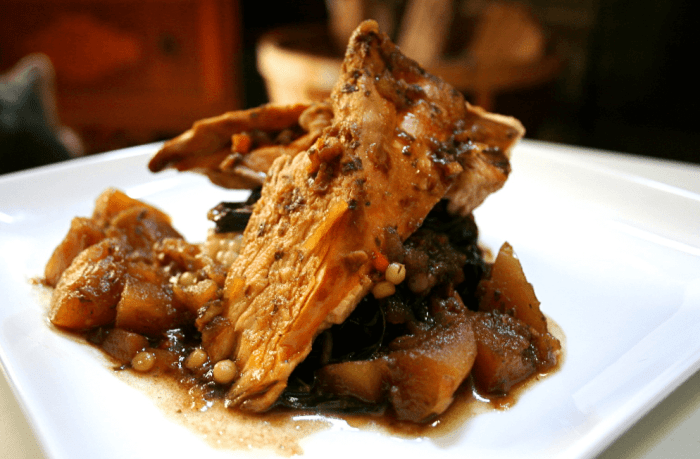
Embark on a culinary adventure with our tantalizing chicken of the woods recipe, a wild delicacy that will ignite your taste buds and expand your culinary horizons. Delve into the enchanting world of this unique mushroom, where earthy flavors intertwine with a vibrant tapestry of textures, promising an unforgettable gastronomic experience.
From sautéing to roasting and grilling, this versatile ingredient unveils its culinary prowess, seamlessly adapting to various cuisines and flavor profiles. Discover the secrets of unlocking its hidden depths, transforming it into delectable dishes that will leave a lasting impression on your palate.
Overview of Chicken of the Woods

Chicken of the Woods is a large, edible mushroom found in forests worldwide. It is known for its bright orange to yellow coloration and its meaty, chicken-like texture.
Chicken of the Woods is a polypore mushroom, meaning it has pores instead of gills on its underside. It typically grows in clusters on dead or dying hardwood trees, particularly oak, maple, and beech. The mushroom has a shelf-like shape, with a wavy or lobed margin.
It can range in size from a few inches to over a foot in diameter.
Nutritional Value
Chicken of the Woods is a good source of dietary fiber, protein, and vitamins. It is also low in calories and fat. The mushroom contains several antioxidants, including ergothioneine and glutathione, which have been shown to have anti-inflammatory and anti-cancer properties.
Types of Chicken of the Woods
There are several different types of Chicken of the Woods, including:
- Laetiporus sulphureus: This is the most common type of Chicken of the Woods. It has a bright orange to yellow color and a meaty texture.
- Laetiporus cincinnatus: This type of Chicken of the Woods is found in North America. It has a more muted orange color and a slightly tougher texture than L. sulphureus.
- Laetiporus conifericola: This type of Chicken of the Woods is found in coniferous forests. It has a darker orange color and a more fibrous texture than the other types.
Culinary Applications

Chicken of the woods offers versatile culinary applications, tantalizing taste buds with its unique flavors and textures.
Its firm, meaty texture lends itself to a range of cooking methods, from sautéing to roasting and grilling. When sautéed, chicken of the woods develops a crispy exterior and a tender, juicy interior. Roasting brings out its earthy notes, while grilling imparts a smoky, charred flavor.
Flavor Profiles
Chicken of the woods pairs harmoniously with a variety of cuisines and flavor profiles. Its delicate flavor allows it to absorb the flavors of marinades and sauces, making it an excellent choice for stir-fries, curries, and pasta dishes.
Its compatibility with herbs and spices is vast. From the aromatic notes of rosemary and thyme to the spicy kick of chili flakes and paprika, chicken of the woods can be seasoned to suit any palate.
Health Benefits and Risks

Chicken of the woods offers a range of potential health benefits due to its nutritional composition and bioactive compounds. It’s rich in antioxidants, which can help protect cells from damage caused by free radicals. Additionally, it contains anti-inflammatory properties, making it a potential dietary aid for conditions like arthritis and other inflammatory disorders.
Risks and Precautions
Despite its health benefits, there are some potential risks and precautions to consider when consuming chicken of the woods. Some individuals may experience allergic reactions, particularly those with sensitivities to mushrooms or molds. It’s essential to consult with a healthcare professional if you have any concerns or known allergies.
Furthermore, chicken of the woods may interact with certain medications, such as anticoagulants. It’s recommended to inform your doctor about your consumption of chicken of the woods, especially if you’re taking any medications.
For a hearty and flavorful meal, check out this chicken of the woods recipe . This wild mushroom has a rich, earthy taste that pairs perfectly with various seasonings and cooking methods. Whether you prefer it as a main course or a side dish, you’ll enjoy its unique and satisfying flavor.
Safe Consumption and Storage
To ensure safe consumption, it’s crucial to properly identify and cook chicken of the woods. Only consume mushrooms that have been positively identified by an experienced mushroom forager or expert. Thoroughly cook the mushrooms before eating to minimize the risk of digestive upset or foodborne illness.
If you’re looking for a delicious and unique vegetarian dish, consider trying a chicken of the woods recipe . This edible mushroom is known for its meaty texture and savory flavor. Whether you sauté, grill, or roast it, you’ll be amazed by its versatility.
For storage, keep fresh chicken of the woods refrigerated in a paper bag or breathable container for up to a week. Avoid freezing, as it can alter the texture and flavor of the mushrooms.
Identification and Foraging: Chicken Of The Woods Recipe
Identifying and foraging chicken of the woods in the wild requires careful observation and knowledge of its distinct characteristics. Here’s a guide to help you distinguish it from similar species and locate it in its ideal habitats.
Habitat and Season
Chicken of the woods prefers to grow on dead or dying hardwood trees, particularly oak, maple, and beech. It typically appears in late summer to early fall, after periods of heavy rainfall.
Distinguishing Features
Chicken of the woods has several distinguishing features that set it apart from other similar-looking mushrooms:
- Shape:It forms shelf-like or bracket-shaped structures that grow out from the trunk of trees.
- Color:The mushroom’s surface is typically bright orange or yellow, with darker orange or red tips.
- Texture:The flesh is firm and meaty, with a slightly rubbery texture when raw.
- Pores:The underside of the mushroom has small, round pores instead of gills.
Similar Species
Be cautious of look-alike species, such as:
- False Chicken of the Woods (Hypholoma fasciculare): This mushroom is typically smaller, with a yellow-green cap and yellow gills.
- Jack-o’-Lantern Mushroom (Omphalotus illudens): This mushroom glows in the dark and has a pale yellow cap with gills.
Ethical and Sustainable Foraging
To ensure the preservation of chicken of the woods and other wild mushrooms, it’s essential to practice ethical and sustainable foraging practices:
- Leave some behind:Only harvest a small portion of the mushrooms you find to allow the colony to regenerate.
- Respect the environment:Avoid disturbing the surrounding vegetation or damaging the tree where the mushrooms are growing.
- Identify correctly:Be absolutely certain of the mushroom’s identity before consuming it.
Nutritional Profile and Comparison

Chicken of the woods is a nutritious edible mushroom that offers a range of health benefits. To better understand its nutritional value, we compare it to two other common edible mushrooms: white button mushrooms and oyster mushrooms.
Calorie and Macronutrient Comparison, Chicken of the woods recipe
| Chicken of the Woods | White Button Mushrooms | Oyster Mushrooms | |
|---|---|---|---|
| Calories (per 100g) | 107 | 22 | 33 |
| Protein (g) | 10.3 | 3.3 | 3.9 |
| Carbohydrates (g) | 19.6 | 3.3 | 6.4 |
| Fiber (g) | 3.8 | 1.3 | 2.3 |
As the table shows, chicken of the woods has a higher calorie and protein content than white button mushrooms and oyster mushrooms. It also contains more carbohydrates and fiber.
Vitamin and Mineral Comparison
| Chicken of the Woods | White Button Mushrooms | Oyster Mushrooms | |
|---|---|---|---|
| Vitamin D (IU) | 0 | 0 | 10 |
| Potassium (mg) | 417 | 318 | 392 |
| Iron (mg) | 1.8 | 0.8 | 2.2 |
| Zinc (mg) | 0.9 | 0.5 | 0.8 |
Chicken of the woods is a good source of potassium and iron, while white button mushrooms are a good source of vitamin D. Oyster mushrooms contain higher levels of iron and zinc.
Nutritional Significance and Health Implications
The nutritional profile of chicken of the woods suggests that it is a nutrient-rich food that can contribute to a healthy diet. Its high protein content makes it a good option for vegetarians and vegans. The fiber in chicken of the woods can help promote digestive health and regularity.
The potassium in chicken of the woods can help regulate blood pressure. The iron in chicken of the woods can help prevent anemia. The zinc in chicken of the woods can help boost the immune system.
It’s important to note that while chicken of the woods is a nutritious food, it should be consumed in moderation. Eating too much chicken of the woods can lead to digestive problems such as gas and bloating.
Final Thoughts

As we bid farewell to our chicken of the woods recipe exploration, let the newfound knowledge and culinary inspiration guide your future culinary endeavors. Remember, the wild holds endless possibilities for those willing to venture beyond the ordinary. Embrace the flavors of nature and continue to create dishes that celebrate the bounty of the earth.
FAQ Explained
What are the health benefits of consuming chicken of the woods?
Chicken of the woods is a nutritional powerhouse, boasting antioxidant and anti-inflammatory properties. It is also a good source of protein, fiber, and essential vitamins and minerals.
How can I identify chicken of the woods in the wild?
Look for large, shelf-like mushrooms with bright orange to yellow caps. They often grow in clusters on dead or dying trees, particularly oak and maple.
What are some ethical and sustainable foraging practices for chicken of the woods?
Only harvest what you need, avoid disturbing the surrounding environment, and always leave some behind for future growth and wildlife.





